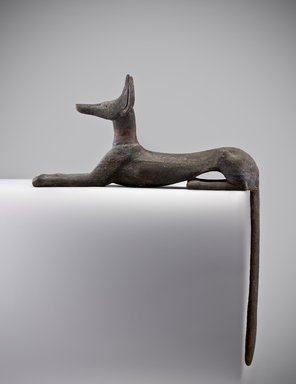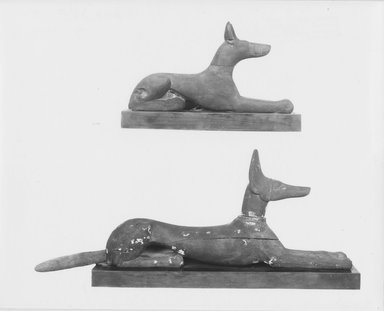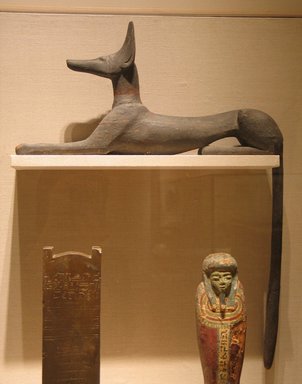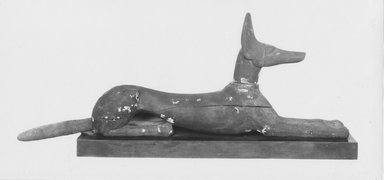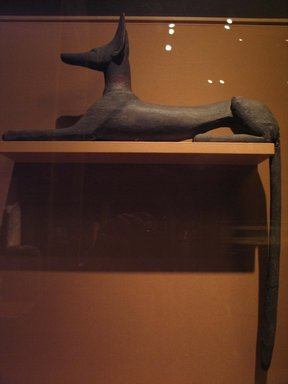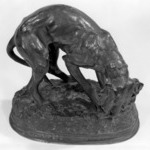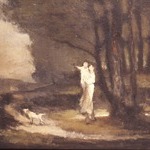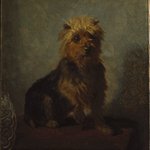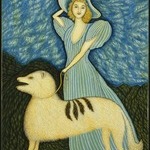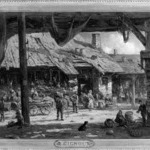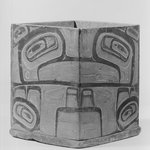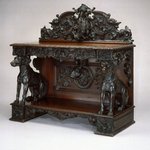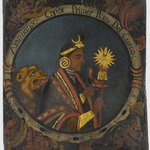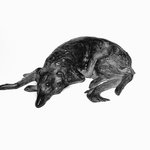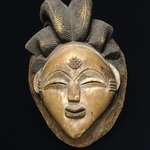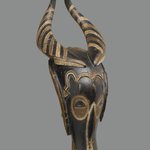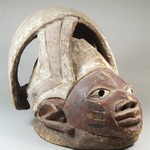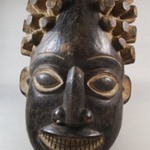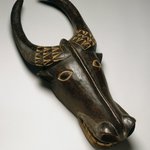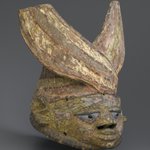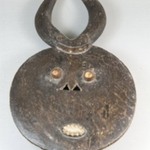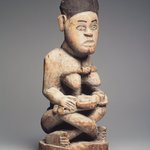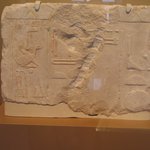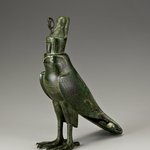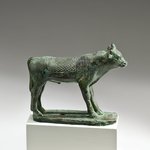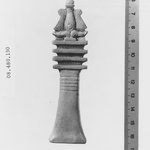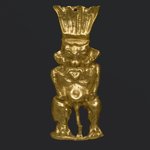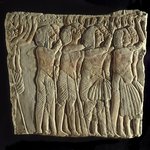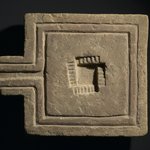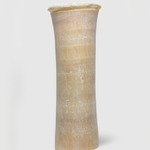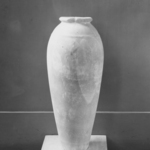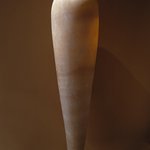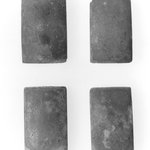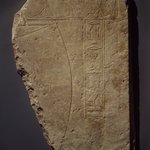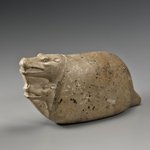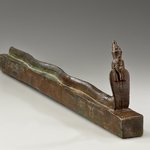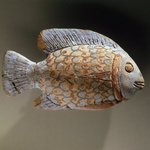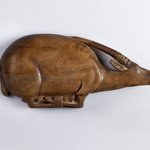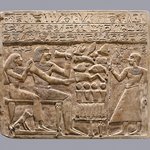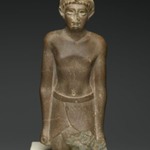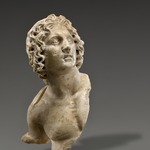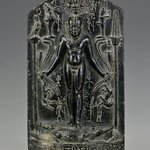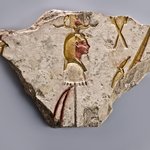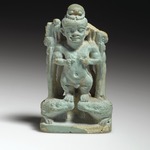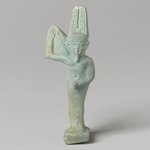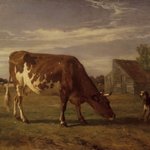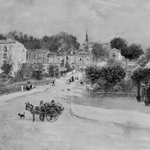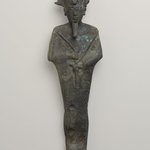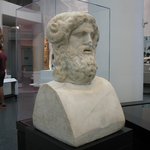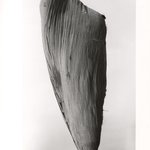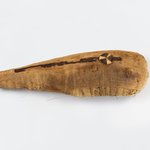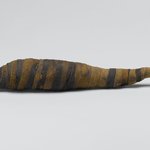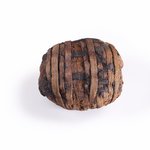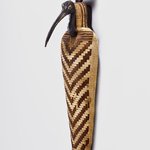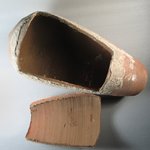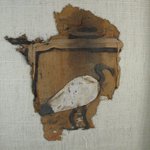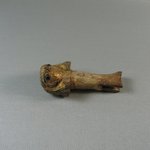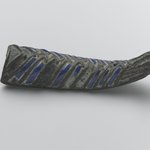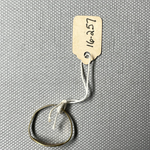Anubis
Egyptian, Classical, Ancient Near Eastern Art
This sleek wooden statue of the jackal god Anubis wearing a red ribbon around his neck depicts him guarding the necropolis, one of his commonest roles. The Egyptians knew that jackals inhabited the desert edge, where cemeteries were located.
The pose Anubis takes here represents the god perched on his sacred mountain above the necropolis, with his tail drooping downward. This is the same form of Anubis addressed in the standard funerary prayer that Egyptian priests recited for the deceased.
MEDIUM
Wood, pigment
DATES
664–30 B.C.E.
DYNASTY
Dynasty 26, or later
PERIOD
Late Period to Ptolemaic Period
DIMENSIONS
26 x 20 x 3 1/2 in. (66 x 50.8 x 8.9 cm)
(show scale)
ACCESSION NUMBER
37.1478Ea-b
CREDIT LINE
Charles Edwin Wilbour Fund
PROVENANCE
Archaeological provenance not yet documented, reportedly from Saqqara, Egypt; by 1852, collected in Egypt by Henry Abbott of Cairo, Egypt and New York, NY; 1859, purchased from Henry Abbott by the New-York Historical Society, New York, NY; 1937, loaned by the New-York Historical Society to the Brooklyn Museum; 1948, purchased from the New-York Historical Society by the Brooklyn Museum.
Provenance FAQ
CATALOGUE DESCRIPTION
Wooden figure of Anubis (a). He is represented recumbent with his tail (b) hanging down behind him. The figure was made of six pieces of wood fastened together with dowels and animal glue. The piece was probably made to rest upon the top of a sarcophagus.
Condition: The face is composed of two separate wooden pieces glued together (one side now lost). These were attached to the rest of the heads via dowels. The neck, once a separate piece, has now been replaced (since it had been lost). A large horizontal crack runs from shoulder to haunches along the left side of the figure. Overall, black paint and red paint of hunting collar are well preserved. Tail (separate) but attached via wax, is well preserved.
MUSEUM LOCATION
This item is not on view
CAPTION
Anubis, 664–30 B.C.E. Wood, pigment, 26 x 20 x 3 1/2 in. (66 x 50.8 x 8.9 cm). Brooklyn Museum, Charles Edwin Wilbour Fund, 37.1478Ea-b. Creative Commons-BY (Photo: Brooklyn Museum (Gavin Ashworth,er), 37.1478E_edited_Gavin_Ashworth_photograph.jpg)
IMAGE
overall, 37.1478E_edited_Gavin_Ashworth_photograph.jpg. Brooklyn Museum photograph (Gavin Ashworth, photographer), 2012
"CUR" at the beginning of an image file name means that the image was created by a curatorial staff member. These study images may be digital point-and-shoot photographs, when we don\'t yet have high-quality studio photography, or they may be scans of older negatives, slides, or photographic prints, providing historical documentation of the object.
RIGHTS STATEMENT
Creative Commons-BY
You may download and use Brooklyn Museum images of this three-dimensional work in accordance with a
Creative Commons license. Fair use, as understood under the United States Copyright Act, may also apply.
Please include caption information from this page and credit the Brooklyn Museum. If you need a high resolution file, please fill out our online
application form (charges apply).
For further information about copyright, we recommend resources at the
United States Library of Congress,
Cornell University,
Copyright and Cultural Institutions: Guidelines for U.S. Libraries, Archives, and Museums, and
Copyright Watch.
For more information about the Museum's rights project, including how rights types are assigned, please see our
blog posts on copyright.
If you have any information regarding this work and rights to it, please contact
copyright@brooklynmuseum.org.
RECORD COMPLETENESS
Not every record you will find here is complete. More information is available for some works than for others, and some entries have been updated more recently. Records are frequently reviewed and revised, and
we welcome any additional information you might have.
